Taking your Driving Test Anxiety is one of those big life milestones that can feel just as exhilarating as it is nerve-wracking. While the thought of earning your license and gaining newfound independence is exciting, test-day pressure often brings an overwhelming sense of anxiety. Sweaty palms, racing thoughts, and that lingering fear of failure can shake even the most prepared test-taker.
The good news? You’re not alone, and driving test anxiety is something you can overcome with the right tools and mindset. Anxiety might trip you up, but it doesn’t have to control the outcome of your test. By understanding what’s behind those jitters and following some tried-and-true tips, you can approach test day with confidence.
Here are 7 essential tips to help you manage driving test anxiety and ace that exam like a pro.
1. Understand the Root of Your Anxiety
The first step to overcoming Driving Test Anxiety is figuring out why you’re feeling nervous in the first place. For most people, the fear isn’t necessarily about driving itself, but rather the potential of failure. You might be worried about making critical mistakes, getting judged by the examiner, or letting your nerves get the best of you.
How to Tackle This:
- Acknowledge Your Feelings: It’s okay to feel nervous! Everyone experiences anxiety in some form. Recognizing your emotions rather than suppressing them is the first step.
- Visualize Success: Picture yourself driving calmly and confidently during the Driving Test Anxiety. Visualization can replace negative thoughts with positive ones, making the experience feel less daunting.
2. Prepare Thoroughly
One of the biggest contributors to Driving Test Anxiety is the fear of the unknown. When you know what to expect on test day and are confident in your skills, a huge weight of uncertainty is lifted. Preparation truly is the antidote to stress.

How to Tackle This:
- Know the Test Structure: Research what the Driving Test Anxiety will cover in your area. It typically includes maneuvers like parallel parking, lane changes, stopping at stop signs, and general road awareness.
- Practice with a Purpose: Focus on areas where you feel less confident. Spend extra time practicing parallel parking, making left turns, or merging if those are trouble spots for you. The more prepared you are, the less you’ll need to worry.
- Take Mock Tests: Simulate the test several times in the days leading up to it. Have a friend or instructor play the role of examiner, giving you directions and feedback.
3. Manage Your Expectations
Many people think they need to drive perfectly to pass their test, but that’s not true at all. Driving examiners expect new drivers to make minor mistakes. What they care most about is your ability to recover quickly and drive safely under pressure.
How to Tackle This:
- Focus on Safety: Instead of worrying about small errors, center your attention on staying composed, checking your Driving Test Anxiety, and adhering to traffic rules.
- Accept Imperfection: If you miss a turn signal or accidentally brake a little hard, don’t panic. A single minor slip-up is unlikely to fail you.
- Set Realistic Goals: Aim to do your best, not be flawless. The goal isn’t 100% perfection, but demonstrating that you’re a responsible and cautious driver.
4. Practice Stress-Reduction Techniques
Nervous energy on test day is natural, but learning how to regulate it Driving Test Anxiety can make a huge difference. Calming your body and mind will keep you focused and prevent anxiety from taking over.
How to Tackle This:
- Breathing Exercises: Use the “4-7-8” method. Breathe in quietly for 4 seconds, hold the breath for 7 seconds, and exhale slowly for 8 seconds. Repeat this a few times to slow your racing heart.
- Progressive Muscle Relaxation: Before bed or on the morning of your test, tense each muscle group (like shoulders, hands, and legs) for a few seconds, then release. This reduces overall body tension.
- Mindfulness Meditation: Spend 5-10 minutes meditating to stay grounded and present. Apps like Headspace or Calm can guide you through quick exercises to center your thoughts.
5. Get Familiar with the Route
Uncertainty about where the test will take place can exacerbate anxiety. Familiarity breeds confidence, so it helps to know the roads where your driving test is likely to occur.
How to Tackle This:
- Practice in the Testing Area: If possible, spend time Driving Test Anxiety in the same vicinity where your test will take place. Pay attention to speed limits, tricky intersections, or areas with high pedestrian traffic.
- Anticipate Challenging Sections: Note potential challenges in those areas, such as busy roundabouts, narrow lanes, or school zones, and practice handling them.
- Ask Questions: If you’re taking lessons with an instructor, don’t hesitate to ask questions about what the examiner might focus on during the route.
6. Prepare for Test Day Like a Pro
How you prepare for test day can greatly influence your mindset. Feeling rushed or unorganized can compound stress, so prioritize creating a calm, controlled environment for yourself.
How to Tackle This:
- Plan Your Schedule: Make sure you know the exact time of your Driving Test Anxiety and arrive at least 15 minutes early. Rushing leads to heightened nerves, so give yourself plenty of time.
- Pack Your Essentials: Bring your learner’s permit, test appointment confirmation, and any paperwork required. Double-check the night before to avoid last-minute scrambling.
- Get Rested and Energized: A solid 7-8 hours of sleep can work wonders for focus and clarity. Eat a light, balanced meal to keep your energy steady.
Bonus Tip:
- If driving your own car for the test, check that everything is functioning properly, including turn signals, brake lights, and the horn. A vehicle in good condition will prevent added Driving Test Anxiety.
7. Learn to Reframe Failure
Even with the best preparation, there’s always a small chance you might not pass on your first attempt. And that’s okay. Failing doesn’t mean you’re a bad driver; it just means you have room to grow and improve.
How to Tackle This:
- See Failure as Feedback: Perhaps you need to spend more time Driving Test Anxiety parking or remembering to check blind spots. Learning from mistakes will make you a better driver in the long run.
- Focus on Progress: Passing a driving test is just one part of your driving journey. Reflect on how much you’ve grown since your first practice session, regardless of the test result.
- Take Another Shot: Many people don’t pass on their first attempt but go on to succeed the second or third time. More practice and a little extra patience are all it takes.
Bonus Tips for Staying Calm on Test Day
Here are a few additional strategies to help you manage the jitters on the morning of your driving test:
- Bring a Support Buddy: Having a parent, friend, or mentor nearby before the test can reduce stress.
- Mute Negative Self-Talk: Replace “What if I fail?” with “I’ve got this.” Shift your focus to the practice and preparation you’ve already done.
- Remember Why You’re Doing This: Think about the Driving Test Anxiety, convenience, and freedom that comes with a driver’s license. Visualize your success and the doors it will open!
Final Thoughts
Driving test anxiety is entirely normal, but it doesn’t have to stand in your way. By preparing thoroughly, staying calm under pressure, and using these anxiety-busting techniques, you’ll be ready to step into that car and give it your best shot.
When the big day comes, be kind to yourself, take a deep breath, and remember that this is just one step on your driving journey. Whether you pass the test this time or need a little more practice, you’re moving forward, and that’s what matters.
You’ve got this! Now go out there and show the examiner the hard work and Driving Test Anxiety you’ve put into becoming a safe, confident driver.










